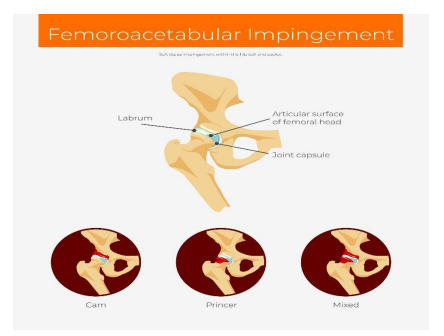Does your hip click when you walk? Does your hip feel stiff? Has the way you walk changed due to the pain in your groin and hip? If you said yes to any of these questions, then you may have Femoroacetabular Impingement (FAI). Read the information below to learn more.
What is Femoroacetabular Impingement (FAI)?
● FAI is caused by irregularly shaped bone growths (bone spurs) along one or both bones that form the hip joint.
● These irregularly shaped bone growths rub against each other during movement, and overtime, they damage the cartilage and labrum, causing pain and decreased physical activity.
● This damage may lead to degeneration and development of hip osteoporosis (OA).
● The cause of FAI is unknown, but studies have found that participants in high impact sports (soccer, basketball, ice hockey, etc.) have a higher prevalence of FAI than nonathletes.
● FAI may begin in adolescence and continue through adulthood.
Signs and Symptoms
● Indications of FAI can be front and front-lateral hip pain that travels to the groin and radiates down the front of the thigh, hip stiffness, and increased pain in positions from activities that require bending at the hip or internal rotation or both.
● Sitting, squatting, and driving can aggravate the symptoms.
● Clicking of the hip or stiffness may be the result of a labral tear or chondral damage.
● A tight psoas tendon or iliotibial (IT) band during physical assessment may indicate FAI.
● Other indications of FAI include a change in gait patterns, decrease in hip range of motion, and lower muscle strength.
● Children may have difficulty describing their pain and may limp after activity.
● If you have any of these symptoms, contact your primary care physician or general practitioner.
Diagnosis and Treatment
● A diagnosis of FAI is based on the results of the hip X-ray to assess acetabular or femoral anatomy and to identify OA of the hip.
● A magnetic resonance imaging (MRI) and magnetic resonance angiography (MRA) can reveal labrum and articular cartilage damage, and a 3D assessment of bone deformity and pressure of impingement cysts.
● The treatment plan depends on the severity of the pain.
● If pain is tolerable, meaning there is a reduction in hip pain, improvement of symptoms, and a decline in disability by focusing on activity modification, movement pattern retraining, muscle strengthening, and pain management, then surgery will not be necessary.
● If the pain is unbearable, then surgical treatment may be needed. These patients will be referred for an orthopedic consult for surgery.
● The goal of surgery is to correct anatomical abnormalities of the hip joint, repair cartilage damage, decrease degeneration of the joint, and prevent hip osteoporosis (OA).
Call to Action
● If you or someone that you know is experiencing any of the symptoms described above, consult with your primary care physician (PCP) or general practitioner as soon as possible.

References
M_Denis. (2020). [Diagram]. Femoroacetabular impingement cheme anatomy poster. https://www.shutterstock.com/image-vector/femoroacetabular-impingement-cheme-anatomy-poster-1746776624.
OrthoInfo. (2020). Femoroacetabular impingement. https://orthoinfo.aaos.org/en/diseases–conditions/femoroacetabular-impingement/.
Pun, S., Kumar, D., & Lane, N. E. (2015). Femoroacetabular impingement. Arthritis & rheumatology (Hoboken, N.J.), 67(1), 17–27. https://doi.org/10.1002/art.38887.
